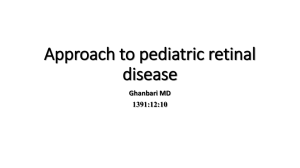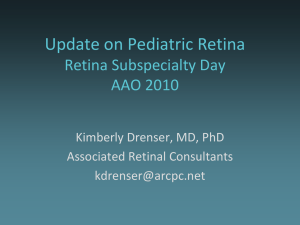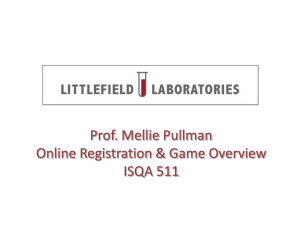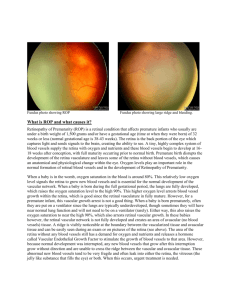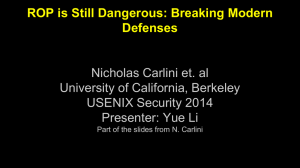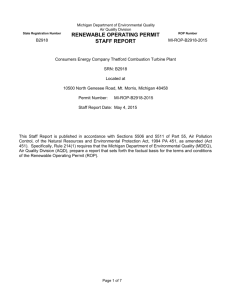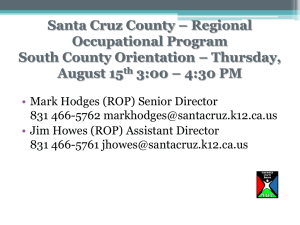ROP - Mumbai Retina Center
advertisement
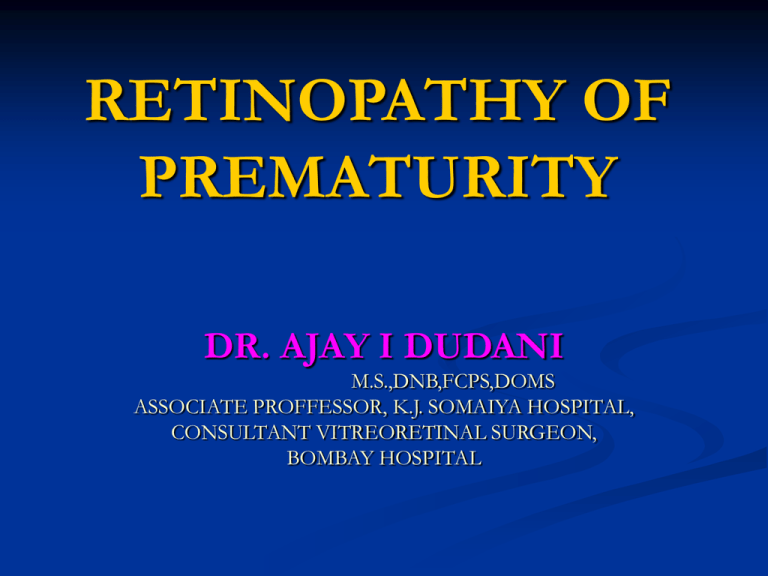
RETINOPATHY OF PREMATURITY DR. AJAY I DUDANI M.S.,DNB,FCPS,DOMS ASSOCIATE PROFFESSOR, K.J. SOMAIYA HOSPITAL, CONSULTANT VITREORETINAL SURGEON, BOMBAY HOSPITAL ROP – why important? India shares 20% of world childhood blindness. Out of 100 preterm infants, 20-40 develop ROP, out of which 3-7 become ultimately blind. The incidence of ROP is increasing due to better survival of LBW & preterm babies availing modern neonatal facilities and care. With early detection and timely intervention blindness is preventable. INTRODUCTION 1st described by Terry in 1942 in 6 month premature infant. Campbell first brought to notice relationship of intensive oxygen therapy & subsequent development of ROP. Kinsey clearly established that ROP was inversely proportional to birth weight. TWO OVERLAPPING PHASES Acute phase- normal vasculogenesis is interrupted & a response to injury is observable in retina. Chronic or late proliferative phase- membranes grow into vitreous causing tractional RD, ectopia or scarring of macula leading to severe visual loss. >90% cases undergo spontaneous regression, <10% cases develop significant cicatrization. RISK FACTORS Prematurity & LBW. (<31 wks,<1500gms) <28wks,<1000gms are at highest risk. Factors causing shift in oxygen –Hb dynamics like : -multiple blood transfusions -intraventricular haemorrhage - cyanosis, apnoea , seizures - neonatal sepsis - shock Endogenous antioxidant deficiency.(vit E and others) In multiple pregnancy, those with better wt gain develop severe ROP Supplemental oxygen did not cause additional progression of prethreshold ROP (STOP-ROP) Ambient light reduction in hospital nurseries has no effect on the development of ROP (LIGHT-ROP) Progression to threshold ROP may be influenced by genetic differences in VEGF production. INTERNATIONAL CLASSIFICATION OF ROP On the basis of Location on the retina Degree or stage of proliferation Extent of proliferation in circumferential manner. STAGES OF ROP 1) Demarcation line 2) Demarcation ridge 3) Ridge with extraretinal fibrovascular proliferation 4A) Subtotal RD B) Subtotal RD involving the macula 5) Total RD STAGES OF ROP STAGE 2—DEMARCATION RIDGE STAGE 3 ROP STAGE 5 ROP ZONES OF ROP 1. 2. 3. Circle drawn from center of the disc with a radius of twice the distance from the disc to the macula Nasal edge of zone 1 to the ora nasally and upto the equator temporally Temporal crescent of retina anterior to zone 2. ZONES OF ROP PLUS DISEASE Increased dilatation & tortuosity of posterior pole vessels Iris vascular engorgement Pupillary rigidity Vitreous haze Normal posterior pole vasculature is a reliable marker for the absence of stage 3, when examination is difficult on account of poor pupillary dilatation in premature infants PLUS DISEASE THRESHOLD ROP Stage 3 disease involving >5 contiguous or 8 interrupted clock hrs with plus disease PRETHRESHOLD ROP Any extent stage 3 in zone 1 with or without plus ds Zone 2 stage 3, < (5 contiguous or 8 noncontiguous clock hrs) Zone 2 stage 3, 5 contiguous or 8 noncontiguous clock hrs without plus ds RUSH DISEASE & CICATRICIAL ROP Unusually aggressive pattern which may proceed very rapidly to severe ROP & RD Cicatrization Sequelae include high myopia, vitreretinal membranes, areas of irregular pigmentation in periphery & dragging of vessels including macula to periphery. Falciform retinal folds in severe cases In most severe cases, totally detached retina forms thickened mass behind lens- Retrolental fibroplasia CICATRITIAL ROP TEMPORAL DRAGGING OF MACULA FALCIFORM VITREORETINAL FOLD TREATMENT OF ROP Cryotherapy Laser therapy Surgical management Threshold ROP is treated within 72hrs by ablation of the avascular retina by laser or cryotherapy. CRYOTHERAPY Advantages Less expensive Widely available Faster to administer Can bypass the thick vasculosa lentis It acts by eliminating the production of vasoproliferative factor from avascular retina Multicentric Cryotherapy Trial for ROP concluded that cryotreatment reduces the risk of unfavourable retinal & functional outcome from threshold ROP CRYO-ROP Study Group – 15 yr follow up of 254 survivors from 291 preterms with birth wts <1251gms & severe threshold ROP in one or both eyes. Treated eyes Unfavourable structural outcome 30% Between 10 &15 yrs of age, 4.5% new retinal folds detachments or obscuring of view of posterior pole Unfavourable visual acuity outcomes 44.5% Control Eyes 51.9% 7.7% 64.3% RESULTS OF CRYO ROP STUDY Benefit of cryo for treatment of threshold ROP for both structural & visual functions was maint ained across 15 yrs of follow up New detachments in eyes with good structural findings at 10, emphasize value of long term regular follow up of eyes with threshold ROP LASER PHOTOCOAGULATION Advantages Ease of delivery No need of general anaesthesia More effective in zone1 (posterior pole ds) Less irritating Scars less pronounced Less induce myopia OS AT 34wks with ROP 4wks Post Laser Regressed ROP EARLY TREATMENT OF ROP (ETROP) This group supported retinal ablative therapy for Type 1 ROPZone 1, any Stage with plus ds Zone 1, Stage 3 without plus ds or Zone 2, Stage 2 or 3 with plus ds And a wait & watch approach for Type 2 ROP Zone 1, Stage 1 or 2 without plus ds Zone 2, Stage 3 without plus ds SURGICAL MANAGEMENT Stage 4A & 4B – scleral buckling Stage 5 – difficult, anatomical & visual results disappointing. Lensectomy & pupilloplasty, mandatory for peripheral approach Retrolental membranes dissected from center to periphery with minimal traction on retina No attempt to drain SRF, Air fluid exchange done Funnel configuration useful to prognosticate surgical outcome PREOP STAGE 5 ROP ATTACHED POSTERIOR POLE 12 WKS POST OP REASONS FOR POOR POST-OP OUTCOME Late disease identification & presentation Lack of prior treatment (cryo or laser) Narrow configuration of RD Associated ocular abnormalities like cataract & glaucoma SCREENING GUIDELINES FOR ROP First done at 32 wks of gestation or 4-5 wks after birth, whichever is earlier At 3 critical stages 32-34 wks 35-37 wks 39-42 wks If no ROP- incomplete vascularisation examined every 2 wkly Early ROP- (Zone 3 & 2 < than prethreshold)- wkly Prethreshold- twice wkly. Last screening till complete retinal vascularisation- 42-45 wks RETCAM FOR ROP DOCUMENTATION Wide angle digital paediatric retinal imaging system Mobile, self contained system for use in nursery, ICU, O.T Easily used by technicians or nurses Avoids stress & expertise of I/O examination & indentation, but as specific and sensitive as I/O Useful for diagnosis, F/U & documentation RETCAM FOR ROP DOCUMENTATION CONCLUSION Timely screening, referral & treatment is key to prevent blindness With, ROP screening programs Awareness amongst ophthalmologists & neonatologists Referral services Advanced vitreoretinal surgical techniques Visual outcome of child suffering from ROP will be brighter!

